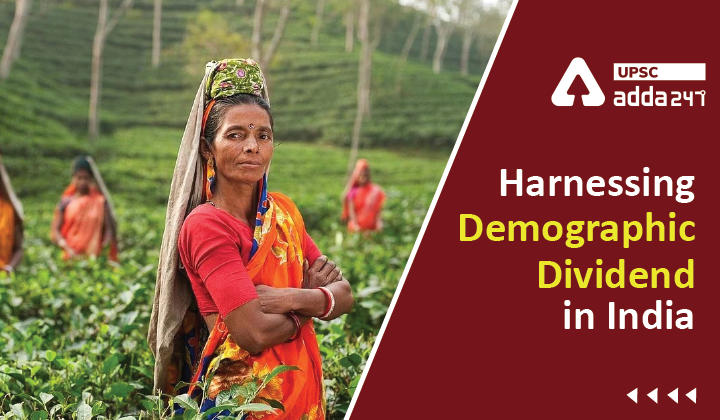Table of Contents
Demographic dividend UPSC
What is demographic dividend?
- Demographic dividend meaning: United Nations Population Fund (UNFPA) defines demographic dividend as the economic growth potential that can result from shifts in a population’s age structure.
- As per several reports, India has one of the youngest populations (62.5% of its population in the age group 15-59) in an aging world.
Demographic dividend benefits and opportunities
- Labour supply: Increased labour supply is the direct benefit of young population, as more people reach working age. The magnitude of this benefit, however, would depend on the ability of the economy to employ these extra workers.
- Capital formation: As the number of dependents decreases in a family, individuals save more. This increase in national savings rates increases the capital stock in developing countries, besides providing an opportunity to create the country’s capital through investment.
- Female Human capital: Decrease in fertility rates result in healthier women and fewer economic pressures at home. This, in turn, provides an opportunity to engage more women in the workforce.
- Economic growth: A majority of young population means demand-driven economic growth. Growth, education, better economic security and a desire for more durable goods are the cause and consequence of young demographics.
- Infrastructure: Increased fiscal space created by the demographic dividend enables the government to spend less on consumption and more on investments.
Demographic dividend and India: Challenges
- Enhancing human capital: Employability is very low among India’s graduates and postgraduates. According to a study by ASSOCHAM, only 20-30 % of engineers find a job according to their skills. India has issue with both unemployment and under employment in the country.
- Low human development: India ranks 130 out of 189 countries in UNDP’s Human Development Index. Even the basic indicators like life expectancy at birth in India (68 years) is much lower than other developing countries.
- Informal economy: Informal nature of economy in India is another challenge in reaping the benefits of demographic transition in India. Majority of the Indian workforce work in unorganised sector where not only they earn lower wages, but also have to live in little social security condition.
- Jobless growth: Growth in the economy is not reflected in the total employment. As per the NSSO (National Sample Survey Organisation) Periodic Labour Force Survey 2017-18, India’s labour force participation rate for the age-group 15-59 years was around 53%, which means around 50% of the workforce is jobless.
- Issue of tilted sex ratio: According ILO and the World Bank, India’s female labour force participation rates have fallen from 34.8 % in 1990 to 27 % in 2013. Without women participation, India can’t dream of reaping demographic dividend.
Demographic dividend and economic growth: Steps needed
- Building human capital: India has to invest more in human capital formation at all levels—ranging from primary education to higher education and vocational training. Investment should also be made in innovation, and research and development to increase the skill sets of its growing working-age population.
- Skill development: To increase employability of young population, skill development is must. Government has started Skill India Mission in 2014 to skill India’s youth. National Skill Development Corporation (NSDC) was established to skill the young population with the overall target of skilling/up skilling 500 million people in India by 2022.
- Education: Enhancing education at all the levels is important. To reap the benefits of demographic dividend, the investment on education should increase to 6% of GDP as recommended by many committees and policies, including the National Education Policy 2020.
- Health: Healthcare forms an important segment of social infrastructure. To strengthen the healthcare sector of India, investment of 2.5 % of GDP should be made into the sector as recommended by the National Health Policy, 2017. Improvement in healthcare infrastructure would ensure higher number of productive days for young labour force, thus increasing the productivity of the economy.
- Job Creation: We need to create ten million jobs per year to absorb the additional young people into the workforce. The number of formal jobs need to be significantly increased, especially in labour intensive sectors and the export-oriented sectors.
- Good governance: Good governance is a prerequisite to development. A country with well-functioning institutions, respect for the rule of law, low level of corruption, respect for property rights, sanctity of contracts etc. are destined to provide equal opportunity to all.
Read about UPSC favorite topics





 TSPSC Group 1 Question Paper 2024, Downl...
TSPSC Group 1 Question Paper 2024, Downl...
 TSPSC Group 1 Answer key 2024 Out, Downl...
TSPSC Group 1 Answer key 2024 Out, Downl...
 UPSC Prelims 2024 Question Paper, Downlo...
UPSC Prelims 2024 Question Paper, Downlo...
